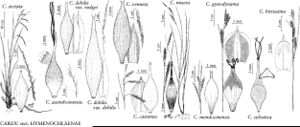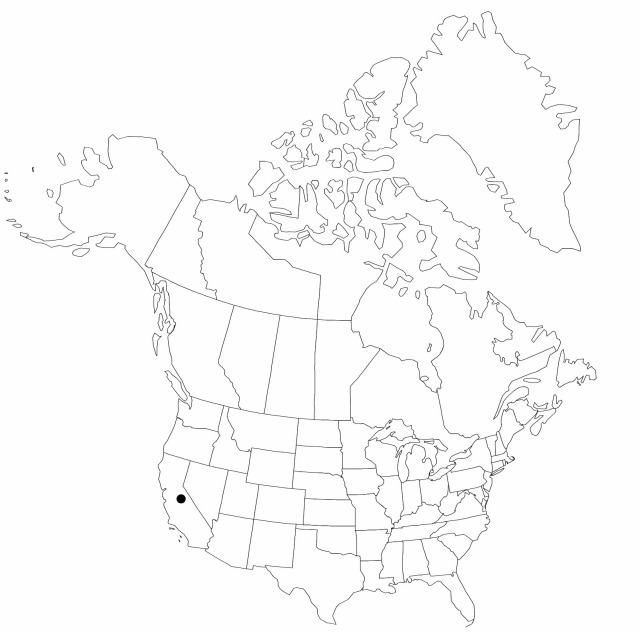Difference between revisions of "Carex hirtissima"
in S. Watson, Bot. California 2: 247. 1880.
FNA>Volume Importer |
imported>Volume Importer |
||
| (5 intermediate revisions by 2 users not shown) | |||
| Line 1: | Line 1: | ||
{{Treatment/ID | {{Treatment/ID | ||
|accepted_name=Carex hirtissima | |accepted_name=Carex hirtissima | ||
| − | |accepted_authority=W. Boott | + | |accepted_authority=W. Boott |
|publications={{Treatment/Publication | |publications={{Treatment/Publication | ||
|title=in S. Watson, Bot. California | |title=in S. Watson, Bot. California | ||
| Line 8: | Line 8: | ||
}} | }} | ||
|common_names=Fuzzy sedge;hairy Sierra sedge | |common_names=Fuzzy sedge;hairy Sierra sedge | ||
| + | |special_status={{Treatment/ID/Special_status | ||
| + | |code=F | ||
| + | |label=Illustrated | ||
| + | }}{{Treatment/ID/Special_status | ||
| + | |code=E | ||
| + | |label=Endemic | ||
| + | }} | ||
|basionyms= | |basionyms= | ||
|synonyms= | |synonyms= | ||
| Line 36: | Line 43: | ||
-->{{#Taxon: | -->{{#Taxon: | ||
name=Carex hirtissima | name=Carex hirtissima | ||
| − | + | |authority=W. Boott | |
| − | |authority=W. Boott | ||
|rank=species | |rank=species | ||
|parent rank=section | |parent rank=section | ||
| Line 50: | Line 56: | ||
|publication title=in S. Watson, Bot. California | |publication title=in S. Watson, Bot. California | ||
|publication year=1880 | |publication year=1880 | ||
| − | |special status= | + | |special status=Illustrated;Endemic |
| − | |source xml=https:// | + | |source xml=https://bitbucket.org/aafc-mbb/fna-data-curation/src/2e0870ddd59836b60bcf96646a41e87ea5a5943a/coarse_grained_fna_xml/V23/V23_866.xml |
|genus=Carex | |genus=Carex | ||
|section=Carex sect. Hymenochlaenae | |section=Carex sect. Hymenochlaenae | ||
Latest revision as of 20:43, 5 November 2020
Plants with short rhizomes, loosely cespitose forming small clumps. Culms reddish brown to dark maroon at base; flowering stems 30–60 cm, much longer than leaves at maturity, 1–1.3 mm thick, sparingly pubescent. Leaves: basal sheaths reddish brown, bladeless, sparingly pubescent; others grading from maroon to green on back, brown-hyaline, often red dotted and pubescent on front, especially near apex; blades flat, 2.7–12 mm wide, usually pilose, more densely so adaxially, margins long-ciliate, except in rare glabrous form. Inflorescences: peduncles of lateral spikes 40–100 mm (proximal spikes) or less than 10 mm (distal spikes), pilose; peduncles of terminal spike to 25 mm, pilose or rarely glabrous; proximal bracts equaling inflorescence or more often shorter; sheaths 5–87 mm; blades 1–3 mm wide. Lateral spikes 2–4, 1 per node, well separated (proximal spikes) or crowded and overlapping staminate spike (distal spikes), erect, pistillate with 20–35 perigynia attached 1–1.5 mm apart, cylindric, 5–30 × 2–7 mm. Terminal spike staminate, rarely gynecandrous, sessile or more commonly pedunculate, 10–27 × 2.2–6 mm. Pistillate scales white-hyaline at base and along margins, suffused with reddish brown near apex, with broad green midrib, broadly ovate, nearly as long as perigynia, apex truncate or rounded with ciliate green awn 1 mm, otherwise glabrous. Perigynia golden green, sometimes red dotted, 2-ribbed and finely 8–10-veined, substipitate, loosely enveloping achene, ellipsoid, 2.5–4.2 × 1–1.8 mm, membranous, apex tapering to beak, entire surface pubescent, often densely so, except in rare glabrous form; beak minutely bidentate, 0.8–1.4 mm, ciliate between apical teeth. Achenes sessile, 2–3.1 × 1–1.7 mm. 2n = 70, 72.
Phenology: Fruiting late spring–early summer.
Habitat: Seeps, wet meadows, springy slopes, open areas in Ponderosa pine forests, clearcuts and disturbed areas, mixed evergreen forests, often associated with serpentine
Elevation: 60–1200 m
Discussion
Carex hirtissima often forms large populations in clear-cut areas, especially near seeps or springs. A completely glabrous form has been collected from within a typical population in Butte County and should be sought elsewhere.

